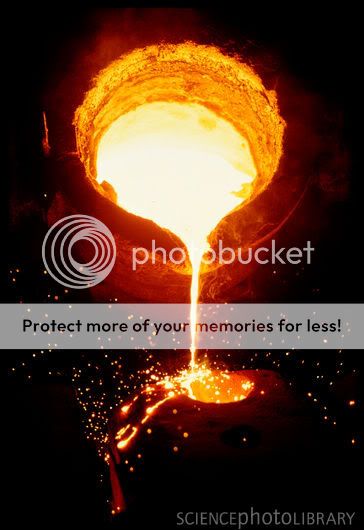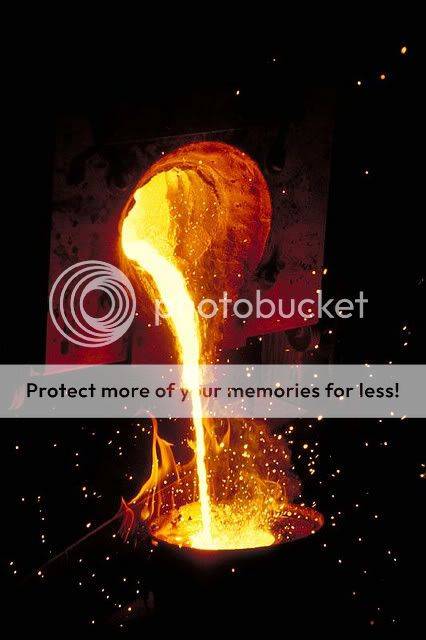I don't understand what properties of aluminum prevent the possibility of it being the molten metal seen at the ground zero site.
Because, as I mentioned numerous already...aluminum melts at a lower temp then steel...But, it gets rid of the heat faster then steel. This means that if it was aluminum that was melting, and running "like in a foundry" there had to be a very high, and constant heating source/fuel supply in order for the aluminum to react, and be in a constant state of melting. Where did this heat fuel source come from? How did it manage to last for 100 days despite constant efforts to extinguish it, and even resorting to thousands of gallons of pyrocool?
Steel on the other hand, will hold onto the heat longer then aluminum, still the source of the heat/fuel source to maintain the temps, in aluminum or steel, that were reported and measured remains a mystery.
My point is that NIST was charged with investigating any and all evidence, reported occurrences etc, and they did not. This is just one of the first instances that go against the investigative agency. By ignoring this, it shows they were not thorough, or complete.
This is my point.
You haven't said how the information about aluminum you've provided in any way effects things. It cools faster than steel? It's used in heatsinks? How does that lead to it being impossible, or even unlikely, that any molten metal seen at the site was aluminum?
What fuel source? Read above...
All that would be needed is a supply of aluminum and enough heat at the time someone witnessed molten metal. It's already been shown that aluminum was in fairly abundant supply in the towers themselves. So, do the circumstances surrounding the molten metal sitings preclude the possibility of it being aluminum? Did the witnesses claim they saw this metal in areas that they knew were cool? Even if that were the case, did they know how long the area had been cool, as molten steel would also harden if cooled long enough?
NIST was charged with supplying answers to your questions. They did not, and this is the point.
Aluminum melts slightly faster then steel but gets rid of its heat faster as well, therefore for aluminum to remain in a molten state, a constant source of extreme temps would be necessary for it to perform this rapid heat transfer, and STILL remain molten.
I haven't seen anyone present how much solid aluminum compared to other metals such as iron/steel there was, anyone have any figures OTHER THEN dust, which we're not talking about at this time?
I believe it was daws who posted a link saying aluminum was used in pretty large amounts in the facing of the towers. Not aluminum dust, solid aluminum.
I'm still waiting for anyone to post the numbers of the quantity of aluminum vs steel.
Not dust sample info.
As I said in my previous post, the details of these eyewitness accounts of molten metal are important. Why must the metal have been molten for long periods of time? It could be that a particular area within the debris heated up due to changing conditions as fires continued to burn, as rubble was moved, etc. So it could be that any molten metal seen, even well after the collapses, was metal that had melted recently.
Another possibility would be isolated pockets of extreme heat. With the amount of materials involved, the idea of an area within the rubble in which fire continued to burn and/or heat being contained is not difficult to believe.
The pools of molten steel/metal were being discovered weeks after the event, and were being uncovered in deep pockets as they proceeded along in the removal of wreckage.
Further, if we assume that the molten metal was in that condition for a long time, what does that mean? What could cause that that wouldn't be consistent with the towers having collapsed due to the planes and fire?
This is what should have been answered by NIST. It's not like they had no time, or budget or enough people to investigate this. Why they didn't we can only speculate about.
I still have seen nothing to indicate any molten metal could not have been aluminum, what am I missing here?
Aluminums more efficient heat transfer rate means that an even greater and constant heat source was initiating the melting.
Look, the WTC towers were made from mostly steel concrete. The core, outer perimeter, trusses, and other supporting components were not fucking aluminum. Molten aluminum is silver in color, steel is orange. I've welded both and seen with my own eyes the difference.
My point in bringing this up first is that it is a main instance of NIST incompetence, or deliberate act of ignoring this important phenomena.
So how much solid aluminum vs solid steel was there in the towers?
What about the testing NIST did that confirms or denies the temps within the towers?
Did their findings indicate any melted steel, that was seemingly confirmed by the melted
components in the piles, and the validation of extreme temps?
IMO,NIST should have just confirmed that there was melted steel in the piles, and blamed it on extreme heat. This would have severely quieted the opposition, but they didn't and this was a big, obvious red flag. Or was it a clue? Could the people at NIST have been leaving a trail of these clues for others to notice, while they were being pressured to write a report on behalf of a demanded agenda?
This speculation can be discussed later, but for now I think I made my point.
Let us try to answer these questions-
So how much solid aluminum vs solid steel was there in the towers?
What about the testing NIST did that confirms or denies the temps within the towers?
Did their findings indicate any melted steel, that was seemingly confirmed by the melted
components in the piles, and the validation of extreme temps?
What about the strength of the steel they tested?


